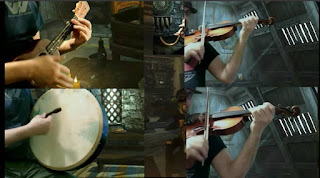The violin part is not working and I may abandon it. Here's the thing; you do home composing with MIDI instruments, you tend to write for strings as if they were a synthesizer pad. So long sustained notes. Which is not exactly easy on a single violin. Certainly not at my level, where each direction change is quite audible. (It's the violin equivalent of running out of breath on a long note).
Also I suspect that it may not be possible to have a part there. The piece as written has a lot of suspect harmonies already. You don't notice because these are fast arpeggios; a maze of twisty little passages, all similar. So all those out-of-chord tones come across as passing tones. Put one of the notes in a long sustained violin passage, though, and you start to notice the bass and the soprano recorder part are in disagreement and there are minor seconds everywhere.
Still, it is something I'd like to try to conquer. If not for this piece, for another. So I'm spending practice sessions just playing single notes over and over, trying for smooth starts and silent bow changes. And, of course, work on my vibrato some more. (Recent experiment demonstrates that hand vibrato might be superior on the chin-cello. Those heavy strings and consequent heavy bow pressure are not as compatible with proper arm vibrato).
And then there's another alternative. Above is a Shetland Gue; this picture being a museum replica by Charlie Bynum. It probably came to the islands North of Scotland with the Vikings, and is strongly related to the Finnish Jouhikko, as well as the Estonian Talharpa, and is a representative of a wide-spread family of bowed lyres (among which belongs the Cretan Lira, which looks rather more violin-like but shares the lack of a fingerboard with the strings being stopped by a light touch on the side).
Unlike the similar-looking plucked lyre of which examples were found in Trondheim and in the Sutton Hoo ship burial, there exist only period descriptions of the Gue. It appears to have had two horsehair strings tuned a fourth (or fifth) apart.
So, yeah. I've ordered the proper black Mongolian horse hair, and a peg hole reamer which just showed up today, but otherwise intend for my first attempt to do a simple pine body.



No comments:
Post a Comment